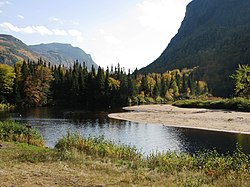| Malbaie River Rivière Malbaie (in French) | |
|---|---|
 Malbaie River in Hautes-Gorges-de-la-Rivière-Malbaie National Park | |
| Location | |
| Country | Canada |
| Province | Quebec |
| Region | Capitale-Nationale |
| Physical characteristics | |
| Source | Petit lac Tristan |
| • location | Lac-Jacques-Cartier (unorganized territory), Capitale-Nationale, Quebec, Canada |
| • coordinates | 47°28′38″N 70°08′50″W / 47.47713°N 70.14722°W |
| • elevation | 893 m (2,930 ft) |
| Mouth | Saint Lawrence Estuary |
• location | La Malbaie, Capitale-Nationale, Quebec, Canada |
• coordinates | 47°39′18″N 70°08′50″W / 47.65500°N 70.14722°W |
• elevation | 0 m (0 ft) |
| Length | 161 km (100 mi)[1] |
| Basin size | 2,059 km2 (795 sq mi)[2] |
| Basin features | |
| Tributaries | |
| • left | (upstream)
|
| • right | (upstream)
|

The Malbaie River in the Charlevoix region empties into the Saint Lawrence River at La Malbaie. Until 1985 the river was used to transport logs downstream. It flows through a steep valley known as Les Hautes Gorges. A sugar maple and American elm forest grows in the gorge and has remained largely undisturbed for hundreds of years.
Its course successively crosses Grands-Jardins National Park, Laurentides Wildlife Reserve, Zec des Martres, Hautes-Gorges-de-la-Rivière-Malbaie National Park and Zec du Lac-au-Sable. It winds first towards the north-east, towards the east, then towards the south-east, in a narrow and deep glacial valley, for 161 kilometers and a drop of 820 meters.
Its course forms a semicircle stretching towards the north and completely encircling in its center the hydrographic slope of the Rivière du Gouffre. For example, there is a distance of 17.1 kilometres (10.6 mi) between the mouth of the rivières des Martres and the mouth of a stream flowing on the east bank of the upper part of the Malbaie River; at the height of this imaginary line, the course of the Malbaie river stretches north to 10.9 kilometres (6.8 mi). While there is a distance of 48.9 kilometres (30.4 mi) between the mouth of the Malbaie river and the mouth of the Petite rivière Malbaie which flows onto the east bank of the upper part the Malbaie River; at the height of this imaginary line, the course of the Malbaie river stretches north to 32.9 kilometres (20.4 mi).[3] Its watershed and that of the rivière du Gouffre form the Charlevoix Biosphere Reserve.
Le Hautes-Gorges-de-la-Rivière-Malbaie National Park is home to Eastern Canada's tallest rock-faced cliffs. Designated a national park (of the province of Québec) in 2000, the 233-km2 Hautes-Gorges is the centrepiece of the UNESCO Charlevoix biosphere reserve.
- ^ "Rivière Malbaie". Banque de noms de lieux du Québec. Commission de toponymie Québec. Retrieved September 4, 2011.
- ^ Perron, Normand; Gauthier, Serge (2000). Histoire de Charlevoix. Institut québécois de recherche sur la culture. ISBN 2-89224-304-1.
- ^ "En Bref: Rivière Malbaie". Saumonquebec.com (in French). Federation of Quebec salmon river managers (FGRSQ). Retrieved July 17, 2016.
© MMXXIII Rich X Search. We shall prevail. All rights reserved. Rich X Search
